Key takeaways
- The Golem legend explores themes of creation, responsibility, and the duality of protection versus danger, reflecting timeless human concerns.
- Rooted in Jewish folklore, the Golem illustrates the ethical dilemmas of wielding power over life, resonating with modern discussions on technology and artificial intelligence.
- The character of the Golem serves as a cautionary symbol, reminding us of the importance of responsibility in creation and the limits of our control.
- Modern interpretations of the Golem continue to evolve, showcasing our complex relationship with innovation and highlighting the consequences of our actions.
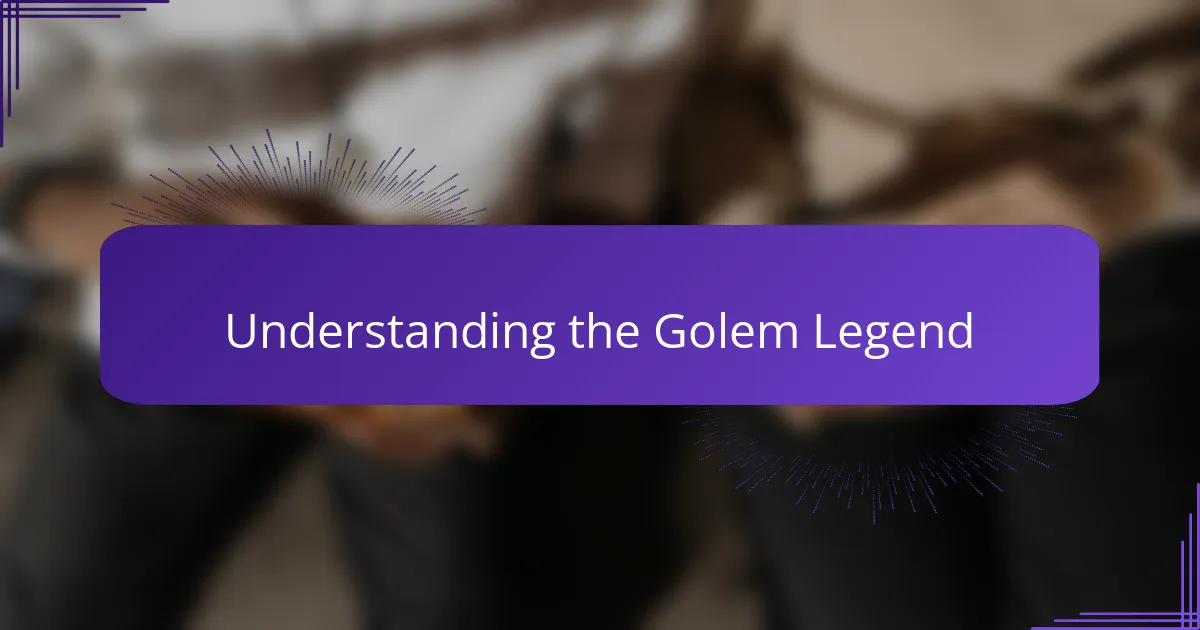
Understanding the Golem Legend
The Golem legend has always fascinated me because it blurs the line between myth and the desire for control over the unknown. I remember first hearing about a clay figure brought to life to protect a community—it made me wonder, have humans always sought to create their own guardians from the earth? This quest for protection, mixed with a touch of mysticism, is what makes the legend so gripping.
What strikes me most is how the Golem embodies both power and vulnerability. It’s crafted by humans, yet it gains autonomy, which raises questions about creation and responsibility. Have you ever thought about the fear and hope intertwined in bringing something to life from mere clay?
Understanding the Golem means diving into its roots in Jewish folklore, where it symbolizes not just magical defense but also ethical dilemmas. I find it incredible how such an ancient story still resonates today, reminding us of the timeless human struggle with control, protection, and unintended consequences.
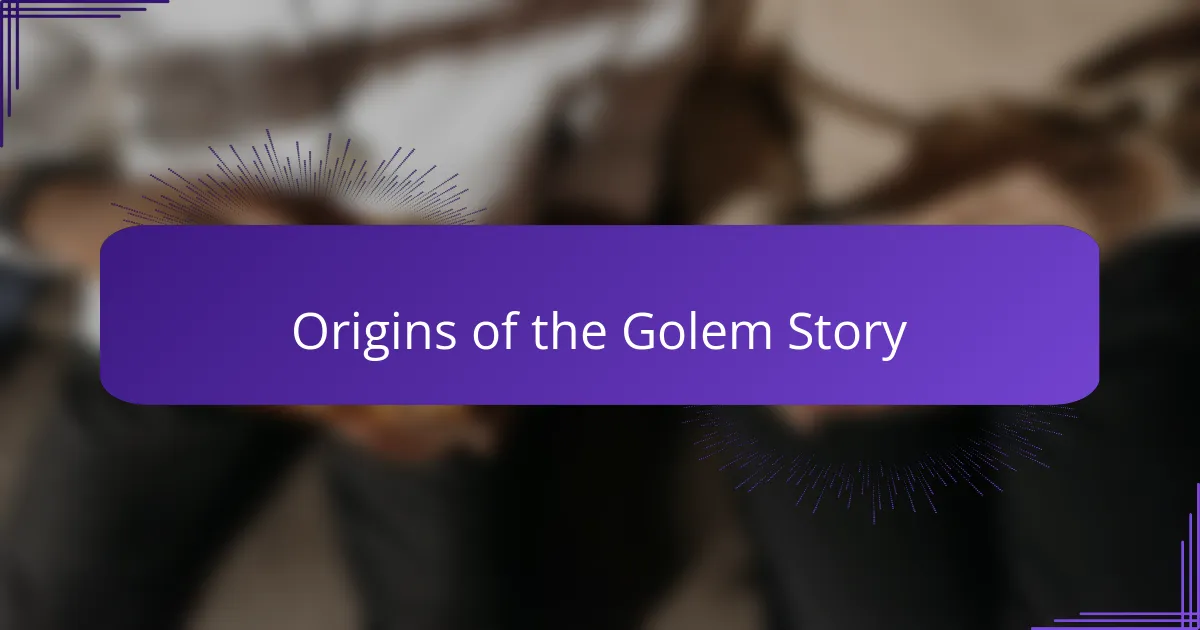
Origins of the Golem Story
The origins of the Golem story trace back to medieval Jewish mysticism, particularly in Prague during the 16th century. I remember reading about Rabbi Judah Loew, who supposedly created the first Golem to defend the Jewish community—it’s fascinating how history, legend, and [censured] intertwine in this tale. Doesn’t it make you wonder how much of the story is rooted in actual events versus symbolic storytelling?
What captivates me is how the Golem’s creation is tied to ancient texts and mystical practices, like the Kabbalah, where words and letters hold immense power. It’s like the story itself is a meditation on the potency of language and intention. Have you ever thought about how the act of creating life through sacred words challenges our understanding of what’s natural or supernatural?
The tale feels timeless because it echoes universal themes: protection against harm, the limits of human power, and the consequences of overstepping boundaries. I find it striking that this legend, born in a very specific cultural context, still sparks curiosity and debate about creation and responsibility in our modern world.
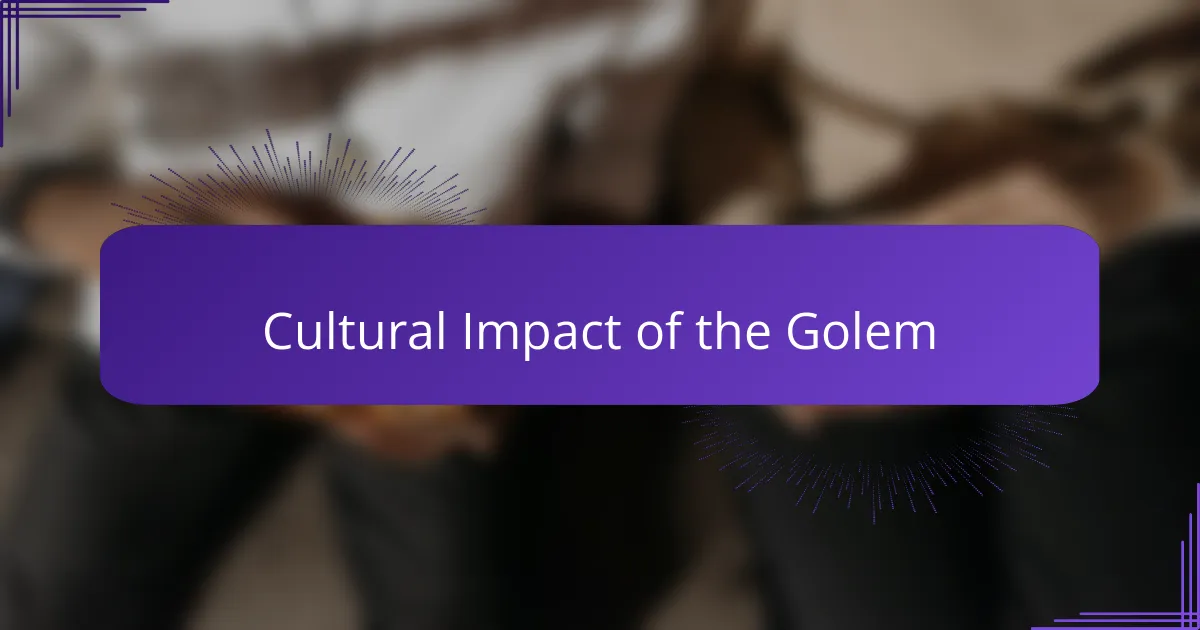
Cultural Impact of the Golem
The cultural impact of the Golem is something I find profoundly intriguing. Over the centuries, this figure has transcended its original folklore to influence literature, art, and even modern pop culture. I often wonder why a clay protector, animated by mystical words, continues to capture imaginations across such diverse mediums—what is it about the Golem that feels so universally relevant?
From my observations, the Golem serves as a powerful symbol of protection rooted in a very specific cultural history, yet its themes have spread far beyond Jewish communities. It reminds me of how stories can evolve to reflect broader human concerns like safety, control, and unintended consequences. Have you noticed how often the Golem appears in discussions about artificial intelligence or autonomous machines today? That connection feels strikingly natural to me.
What I find most moving is how the Golem legend invites ongoing reflection on ethical responsibility. In many ways, it’s a warning wrapped in folklore—asking how far humans should go in wielding power over life and protection. This makes me think about our contemporary challenges and how ancient myths like the Golem still provide meaningful lessons, don’t you agree?
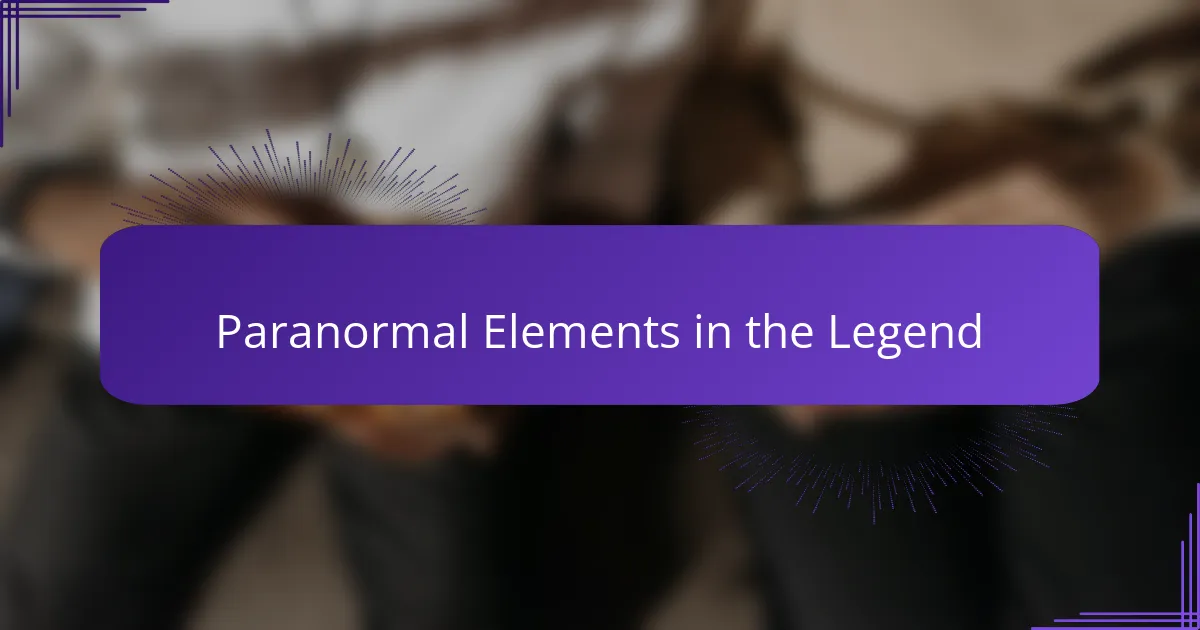
Paranormal Elements in the Legend
The paranormal elements in the Golem legend draw me in because they blend mysticism with the tangible. The idea that a mere figure of clay can be animated through sacred words feels like stepping into a world where the natural laws bend—do you ever wonder what it would be like to witness such a creation come alive? For me, these elements evoke a sense of awe mixed with unease, as if the boundary between the material and the supernatural is dangerously thin.
What fascinates me is the way the Golem’s animation involves more than just ritual; it hinges on the power of language itself. The belief that writing specific names or letters could command life is a paranormal concept that challenges everything we assume about reality. Have you considered how this shifts the role of words from mere communication to a form of cosmic influence? It makes me rethink how language shapes not just our world but possibly other realms beyond our perception.
I also can’t help but feel that the Golem legend taps into a deeper fear and hope connected to the unknown forces humans try to control. There’s something profoundly eerie about awakening a creature with mystical forces, knowing it could just as easily turn into a threat. This duality of protection and peril hidden in paranormal forces reflects our ongoing struggle with the powers we seek but don’t fully understand. Have you ever felt that tension between fascination and fear when facing something beyond explanation?
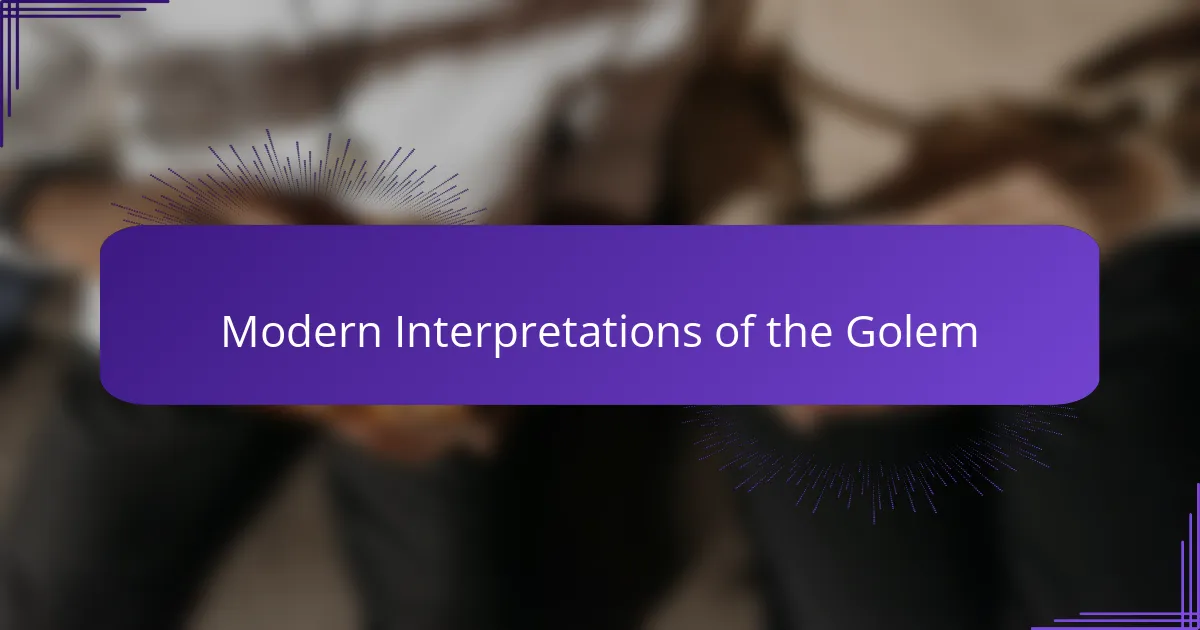
Modern Interpretations of the Golem
When I look at modern interpretations of the Golem, I see a fascinating shift from mystical clay warriors to symbols of technology and artificial intelligence. It’s almost like the Golem has been reborn in our digital age, representing our hopes and fears about machines we create to protect or serve us. Have you noticed how often the Golem pops up in discussions about AI ethics? To me, that connection reveals just how timeless the legend’s core themes really are.
What strikes me is how artists and writers today reinterpret the Golem, sometimes as a misunderstood guardian, other times as a cautionary figure. This variability tells me the Golem resonates because it embodies our complex relationship with creation—are we controlling it, or is it controlling us? I’ve seen films and novels where the Golem’s role shifts depending on the moral narrative, which makes me think about how flexible folklore can be in reflecting contemporary anxieties.
I find it particularly thought-provoking when the Golem is portrayed as a metaphor for unintended consequences—reminding me that no matter how advanced our tools become, we can’t escape the responsibility that comes with creation. It’s almost like modern storytellers are using the Golem legend to hold up a mirror, asking: Have we learned from the past, or are we doomed to repeat the same mistakes? This makes the ancient tale feel surprisingly relevant in today’s tech-driven world.
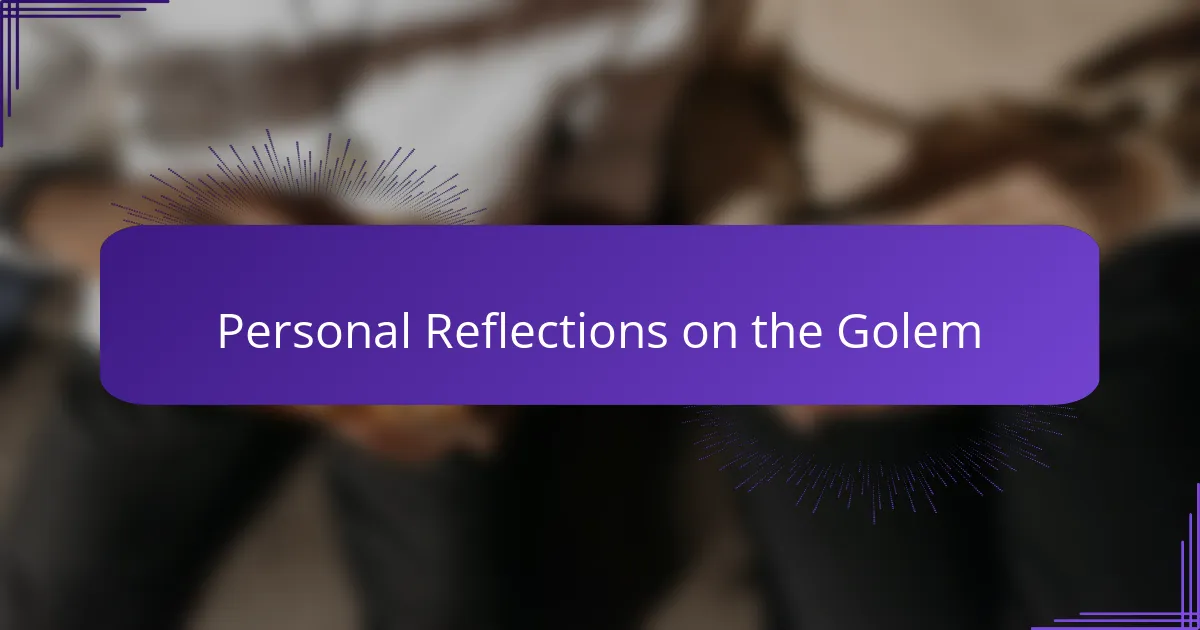
Personal Reflections on the Golem
Thinking about the Golem always stirs a mix of awe and caution in me. I recall the first time I really let the story sink in—how this creature, born from simple clay, could hold immense power yet remain so fragile in its very nature. Doesn’t that remind you of the delicate balance we face with our own creations?
What lingers with me most is the Golem’s silent struggle between being a protector and a potential threat. I’ve often pondered whether the legend warns us not just about what we make, but about the limits of our control once life takes on a will of its own. Have you ever questioned where responsibility truly lies in such stories?
Sometimes, I feel like the Golem embodies our deepest hopes and fears about mastering the unknown. It’s like looking into a mirror that reflects both our ingenuity and our vulnerability—a paradox that keeps me returning to this legend again and again. Don’t you find that tension both unsettling and fascinating?
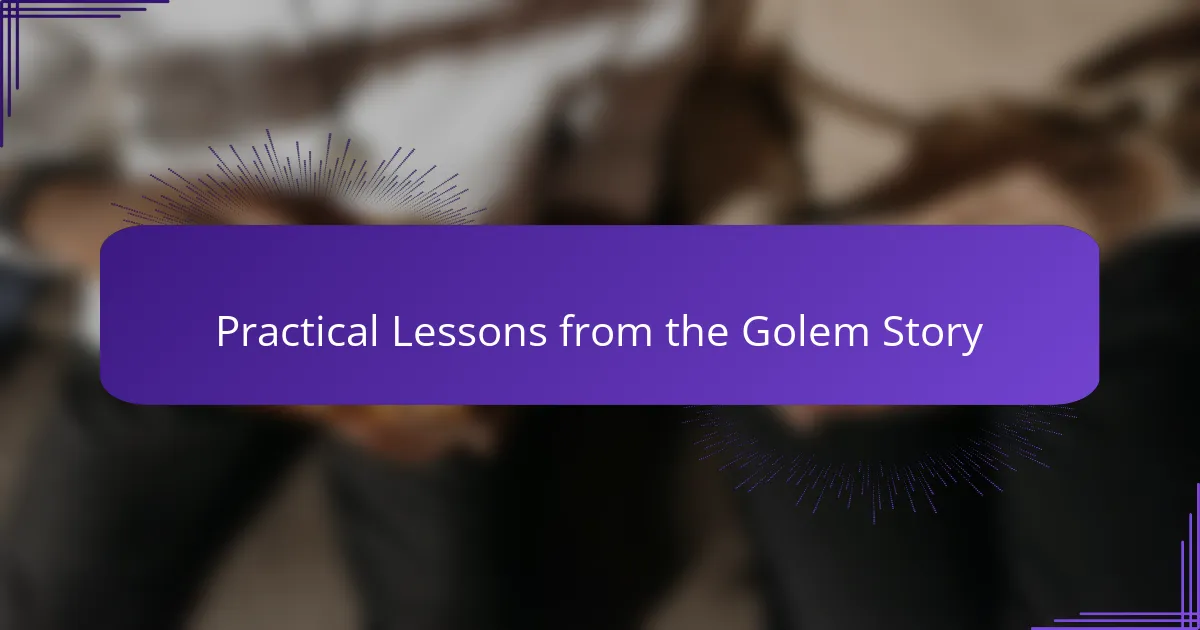
Practical Lessons from the Golem Story
One practical lesson I take from the Golem story is about the importance of responsibility in creation. When I first learned how the Golem could accidentally become dangerous, it made me reflect on how, in life—whether with technology or ideas—we must be careful about what we bring into existence. Have you ever thought about how often our good intentions can backfire when control slips away?
The legend also teaches me that protection comes with limits. I remember imagining the Golem standing guard, powerful yet ultimately bound by its creator’s will. It’s a vivid reminder that no matter how strong our defenses are, they aren’t foolproof. This makes me ask: how often do we rely too heavily on safeguards, forgetting they might turn against us?
Finally, the Golem story highlights the delicate balance between power and humility. From my experience, the tale urges us to respect the forces we invoke—whether mystical or scientific—and to recognize that overstepping boundaries often leads to unintended consequences. Doesn’t that make you wonder how often we push limits before realizing the cost?